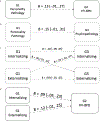The Impact of Personality Pathology Across Three Generations: Evidence from the St. Louis Personality and Intergenerational Network Study
- PMID: 35433118
- PMCID: PMC9009746
- DOI: 10.1177/2167702621989665
The Impact of Personality Pathology Across Three Generations: Evidence from the St. Louis Personality and Intergenerational Network Study
Abstract
Personality disorder (PD) symptoms in a parent generation may confer risk for problems in future generations, but intergenerational transmission has not been studied beyond parent-child effects. We examined the generational transfer of risk associated with PDs using structural models of grandparent personality pathology and grandchild psychopathology among 180 adults (M age =66.9), 218 of their children (M age =41.2), and 337 of their grandchildren (M age =10.5). We found evidence for general and heterotypic domain-specific transmission. Specifically, broad grandparent personality pathology was associated with broad grandchild psychopathology (B=.15, 95% CI [-.01, .31]); at the domain level, grandparent internalizing personality pathology was associated with grandchild externalizing psychopathology (B =.06, 95% CI [.01, .12]). Neither association was significantly mediated by parental personality pathology. These findings indicate that personality pathology in one generation confers risk for psychopathology across subsequent generations. Such intergenerational transmission operates across broad, rather than specific (i.e., individual disorder) psychopathology domains.
Keywords: developmental psychopathology; grandchildren; intergenerational transmission; personality pathology; risk.
Figures



References
-
- Achenbach TM (1966). The classification of children’s psychiatric symptoms: A factor-analytic study. Psychological Monographs: General and Applied, 80(7), 1. - PubMed
-
- Achenbach TM, & Edelbrock CS (1978). The classification of child psychopathology: A review and analysis of empirical efforts. Psychological Bulletin, 85(6), 1275. - PubMed
-
- Achenbach TM, & Rescorla L. (2001). ASEBA school-age forms & profiles. ASEBA, Burlington, VT.
-
- Adshead G. (2015). Parenting and personality disorder: Clinical and child protection implications. BJPsych Advances, 21(1), 15–22. 10.1192/apt.bp.113.011627 - DOI
-
- American Psychiatric Association. (2013). Diagnostic and statistical manual of mental disorders (DSM-5®). American Psychiatric Pub.
Grants and funding
LinkOut - more resources
Full Text Sources
Other Literature Sources
Miscellaneous
